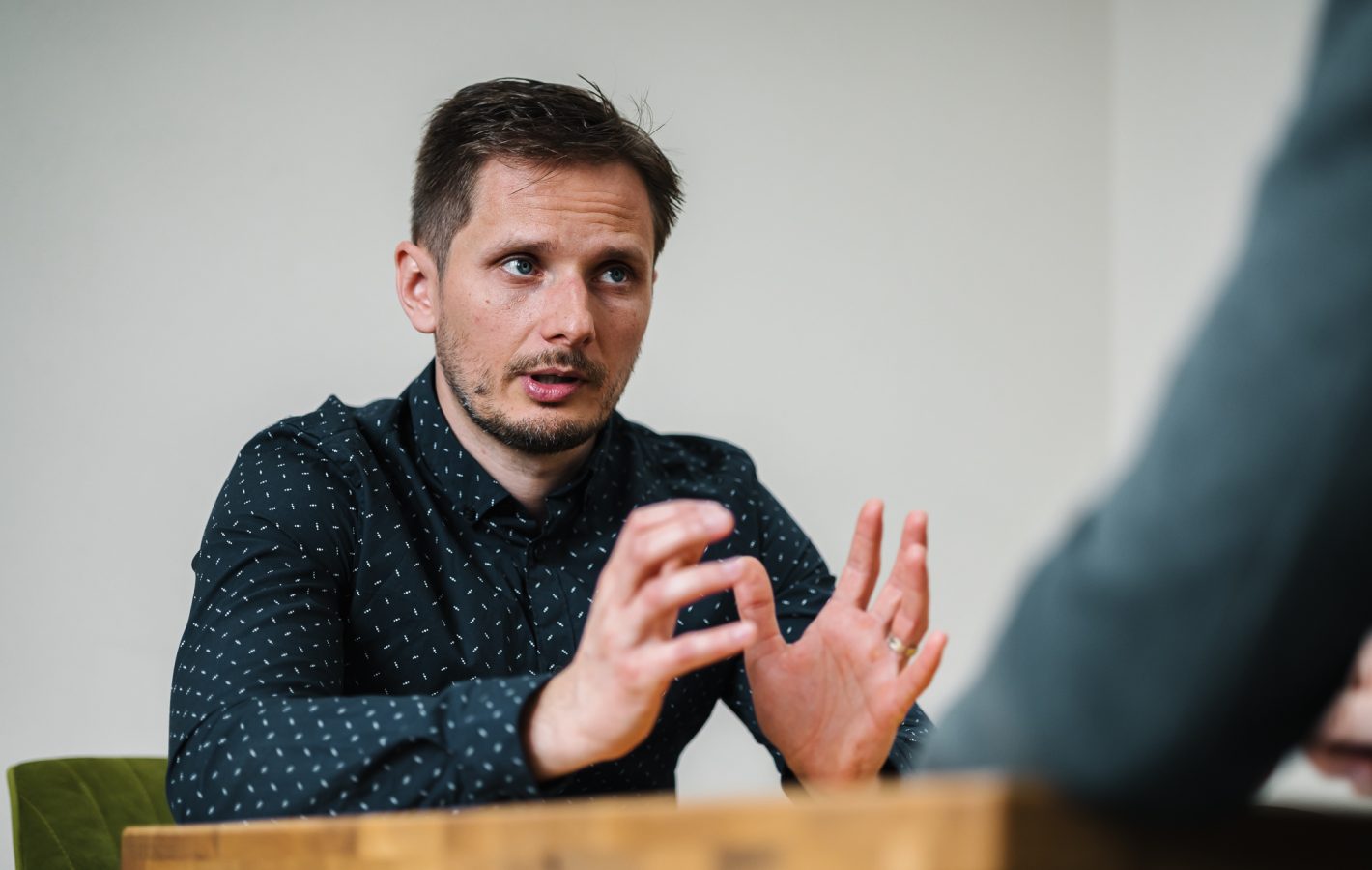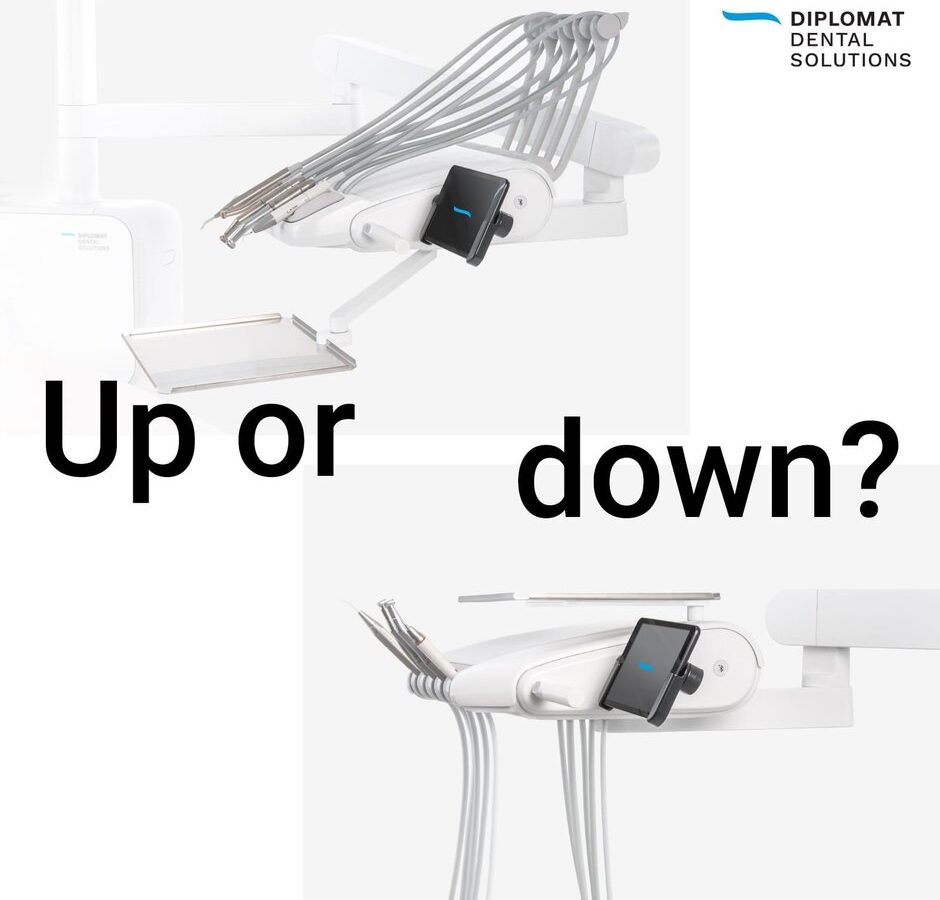In this interview you’ll find out:
- How to build and manage a successful dental clinic
- How does the Lisý dental clinic differ from its competition
- What is the role of new technologies in modern dentistry
- How do smart dental chairs by Diplomat Dental make his work more efficient
- What guarantees satisfaction, returning patients and receiving positive references
- Why is a holistic approach to diagnosis and treatment increasingly important
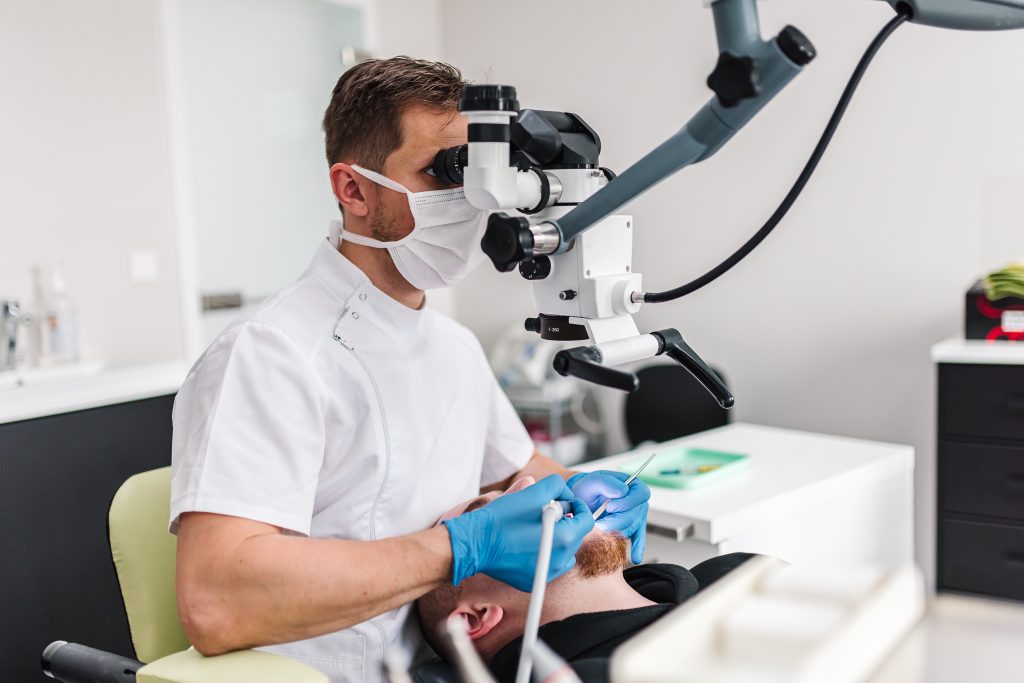
What led you to the dental craft? Is it a family tradition or are you the first in your family?
I was the first in my family to study medicine. From a young age, I always had a clear goal I wanted to be a doctor. My mother was a chemistry teacher in high school, so she prepared me well in this subject. I was accepted into studying general medicine. My second year saw a turning point when a former student of my mother, a well-known dentist, called on me to visit his outpatient clinic to show me how dentistry worked. I was not interested in dentistry at that time at all but I enjoyed surgery as a speciality subject. However, I was shown a very wide range of dentistry activities, from aesthetics to the use of new technologies. That was something that fascinated me. This was a job where the results of your work grow ‘right under your hands’ and that’s very fulfilling. It was one of the decisive factors in why I followed this path. I am still very grateful and have never regretted it.
When did you decide to set up your first dental practice?
I studied and graduated in my hometown of Bratislava in Slovakia. I began working in the town of Hlohovec in Slovakia where I passed my attestation and I also met my wife, Soňa. She was a dentist too so the decision to have a clinic together was done without any hesitation. My wife hails from Stará Turá, Slovakia, so we ended up opening the clinic right there.
What procedures do you specialise in?
In Slovakia, we graduate as Doctors of Dental Medicine with the title DMD or DDS. Worldwide, however, it is divided into several specialisations, for which there are various postgraduate programs. We specialise only in dental surgery and maxillofacial orthopaedics. I specialise in endodontics, i.e. treatment of dental canals, as well as fixed prosthetics, i.e. dental prostheses.
”Today’s dentistry is diametrically different from that of thirty years ago, the difference is enormous. This applies not only to technological equipment and material but also to the knowledge.“
Which dental procedures have changed the most over time?
Fundamentally everything has changed. We had to gradually learn everything again and now we use very little to none of what we were taught at University. Today’s dentistry is diametrically different from that of thirty years ago, the difference is enormous. This applies not only to technological equipment and material but also to knowledge.
Which country dictates the newest dentistry trends?
I would definitely say that the USA is one of the top destinations that set professional trends. They are gradually coming to Western Europe and then, of course, to us. We draw our know-how directly from the USA at our clinic in terms of knowledge or technology.
As we grew bigger, we figured out what suited us the most or the least. Our gradual development and an accumulation of our own experiences have probably been the most useful tools for running a clinic.
How was the idea to open your own clinic born?
Setting up a dentist’s office today is not that difficult. There are several options. The easiest way is to buy an active dental practice and continue with what someone has already started. However, if you wish to start from scratch, you need to attain some knowledge regarding building standards, rules of workplace ergonomics and the actual work itself. Currently, the studies and legislation is set up in a way that the graduating faculty students already get an attestation. I don’t think this is ideal. Someone who has no experience in running a dental practice or in treating patients may, at their own risk, treat patients and run an outpatient clinic or clinic. It would be better if the fresh graduates first learned from someone who already has the practical experience of running a clinic or treating patients. My experience working in Hlohovec, Slovakia taught me a lot and inspired me.
There were also a lot of things my wife and I wanted to do differently. We had our own view of the world of dentistry and patient care. It was therefore natural for us to want to set up our own practice. At first, we opened only one one and we gradually added more. Since we set it up in a small town, without health insurance companies and with only a direct payment option, we were not sure how people would react to it. Six years later, we decided to build something of our own in the same area. We have progressed from one dental practice to owning an entire clinic. As we grew bigger, we figured out what suited us the most or the least. Our gradual development and the accumulation of our own experiences have probably been the most useful tools for running a clinic.

Who is currently part of your team?
My wife focuses on conservative pedostomatology and maxillofacial orthopaedics for adults and children. I deal with essential conservation dentistry, microscopic dentistry, prosthetics and endodontics. Then we have a doctor who deals with restorative dentistry, and another one who specialises in surgery and implantology. We also have nurses, a dental hygienist, an intern, a preventionist, and a receptionist as part of our team.
“We want to keep up with the times. Patients see the difference. It is not just about dental equipment and all modern technology but also about the fact that the patients really feel comfortable with us.“
On what criteria do you select members of your team?
We want to make sure that all our members work well together and offer top-quality expertise and service. We all simply love doing what we do and it does not feel like work to us. Probably the most important thing is that every single member of the team is really dedicated to their job and is kind to patients and other team members. There is a friendly atmosphere here, we are not just colleagues, and we essentially have zero staff fluctuation. We constantly try to progress and we take extra care when hiring new staff. We want professionals who are hardworking but enjoy it. It’s important to keep delivering quality results, keep on educating yourself, as well as glue well with the team.
What is the role of modernisation in contemporary dentistry?
We want to keep up with the times. Patients see the difference. It is not just about dental equipment and all modern technology, but it is also about the fact that the patients really feel comfortable with us. They feel absolute comfort while sitting or lying in a top-notch dental chair. Patients also appreciate the monitor, where they can watch a movie and time will pass faster. We are proactive, we actively remind patients of their upcoming dental checks, and we save them time and energy – all of this is enhancing the client’s experience. Dental technology itself has also progressed. Here we look at dental technology mainly from a functional point of view, and never for the sake of marketing. We have some technologies on the waiting list but the time has not yet come for us to buy them. We need to be trained and educated enough that we can get the most out of the technology we’ll invest in later.
“Our clinic in particular uses microscopy in almost every procedure, such as tooth repairs, prosthetics, endodontics, and also with paediatric patients. Even the routine repair of a small filler, if not done accurately, can fail over time and cause a bigger problem. Therefore, the microscope has become a standard part of the treatment for us.“
What has microscopic dentistry brought to your practice?
Microscopy has been experiencing a boom in the last decade. Microscopic equipment has also become significantly cheaper for dentists, so it’s more widely used now and more dentists are realising its value. Even the best eyes can only see so much but it’s not possible to see every detail. With a microscope, we can detect every little detail on a tooth or tissue. Dentistry and tooth repair is about precision, and microscopy is an excellent aid. However, this type of equipment is not yet common in our clinics and some dentists use it only for certain types of procedures, i.e. the treatment of root canals.
Our clinic, in particular, uses microscopy in almost every procedure, such as tooth repairs, prosthetics, endodontics, and also with paediatric patients. Even a routine repair of a small filler, if not done accurately, can fail over time and cause a bigger problem. Therefore, the microscope has become a standard part of our treatment for us.
Microscopic dentistry | The team at the ‘Somadent’ dental clinic treats patients based on the latest scientific knowledge. Their investment in modern technologies helps them push the boundaries of diagnostics and treatment of their patients. The standard technological equipment for nearly all their examinations and procedures is an operating microscope. The teeth or dental structures are too small and the current performance technology is too complex for the doctor’s eye to be able to perceive all the details. Therefore, the attending physician must enlarge the treated teeth using microscope optics, which results in much more accurate and precise procedures.
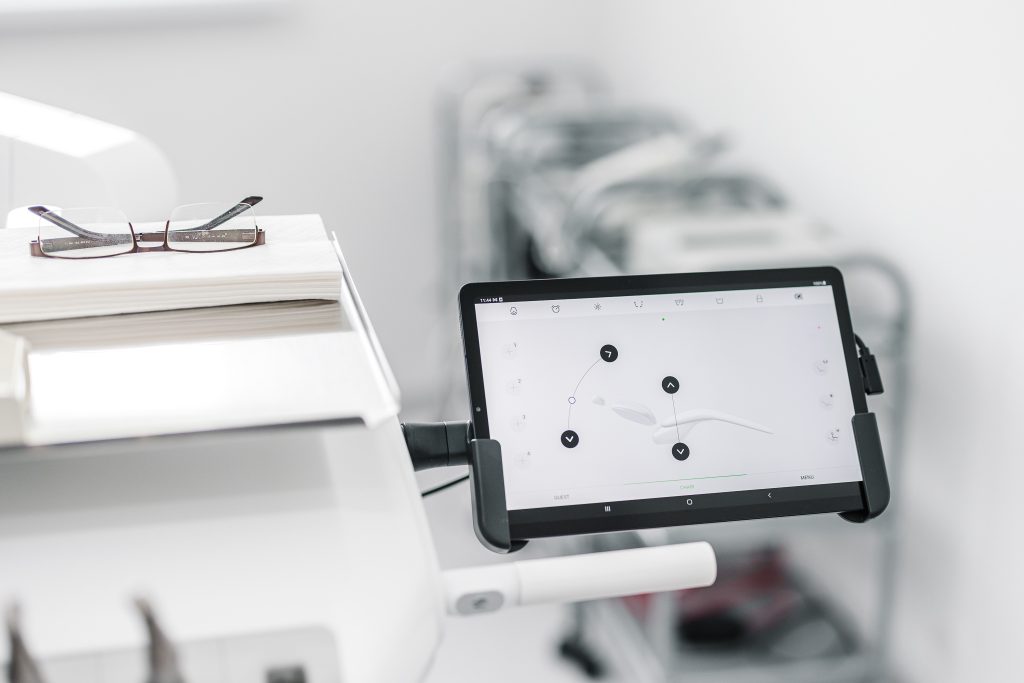
What is the biggest priority when setting up a dental practice or a clinic?
When we set up the clinic, my wife and I both imagined being a patient and moved around the clinic as if coming for treatment. We mapped out where they would enter, where they would sit, where they’d leave their personal belongings and how they’d approach the reception desk. We counted how many people would likely be around, and where they would enter a lift or use the stairs so we could make their movement the most efficient and comfortable as possible within the clinic. The clinic must obviously be well equipped and staffed too. Everyone needs to know exactly what needs to be done and at what time.
We learned this gradually, as we started with one dentist’s office where we did everything from ordering the materials to cleaning it ourselves. Now we have an efficient system for everything to be in place and with minimum to no effort. As far as ergonomics is concerned, each dentist will adapt their dental practice in their own way. However, it is important to think about the movements of team members, so that for example the nurses won’t get in the way of the dentists and vice versa while they sterilise equipment etc. We gained this knowledge during various management and ergonomic training and webinars with the top experts.
“We treat our patients the same way we’d like to be treated. We want to offer a world-class and impeccable service. This requires a calm environment, with plenty of time and space, of course. We build quality relationships with our patients. This matters to us more than focusing on the number of patients and higher profits.“
Why do you take on a smaller number of patients?
It’s about an individual choice. Some clinics focus on a high number of patients. They also might employ several young doctors, often without experience, who will get a very short time to treat each patient as they have too many to treat in a day. We avoid such an approach. We enjoy our work and we want to do it properly. We treat our patients the same way we’d like to be treated. We want to offer a world-class and impeccable service.
This requires a calm environment, with plenty of time and space, of course. It’s a nightmare scenario, with twenty patients in pain, sitting in the waiting room and you’re just trying to hit the daily quota of patients, at the expense of quality treatment for each patient. It’s not just about the money, it’s about the right balance and mostly about very satisfied, smiling and grateful patients. Word of mouth is our best advertising. Many of our patients have gradually become our friends, and they recommended us to more and more people. We get patients from all sorts of locations,
near and far, including from across the country.
What is your recipe for quality care and how do you help clients overcome fear?
The patient is usually unable to assess the technological side of dental treatment. They do not see the details, but they perceive whether it hurts or not, whether the procedure is sufficiently explained, and whether I am an expert enough to reasonably explain to them and for them to understand why and how we perform a specific procedure. My goal is for them to understand what’s going on with their body and teeth. An individual approach, personal comfort, but also a warm welcome in the clinic is important. We address our patients by their first names. These are things when you say to yourself: ‘Yes, I feel really good here.’
How would a patient recognise a quality dental clinic?
‘I feel comfortable here, I feel no pain, nothing fell out of my mouth after the treatment, and it stayed in its place.’ This is just a basic view of whether it is a good dental clinic. However, the available equipment is also important. If you come to a dentist’s office but they send you to get an X-ray elsewhere, it means that the dentist does not have the basic equipment. It is also about the approach.
When they patiently explain everything to you, as a patient, and you see the confidence in the dentist’s expertise to handle any complicated procedures, you are guaranteed to be in good hands. Another important thing is the dentist’s attitude when they’re dealing with a complaint or any other problems. If they can acknowledge an error on their part and resolve it for free, this is something that patients notice and they’ll appreciate this kind of level of service.
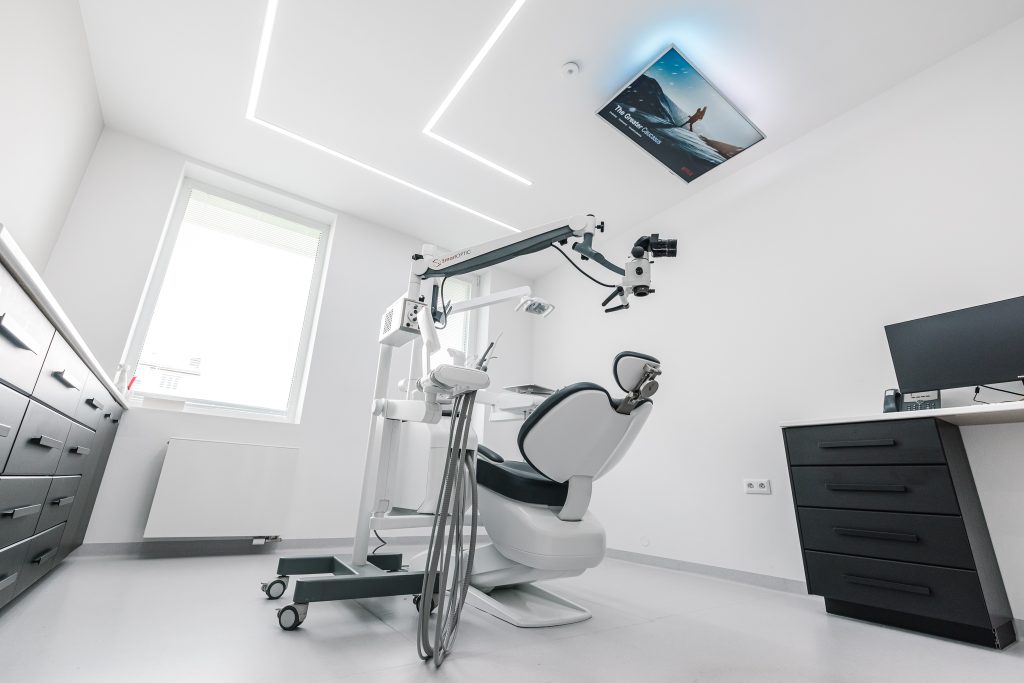
“Dental units by Diplomat Dental are truly excellent in my opinion. They are constantly progressing on a technological level and their dental units are among the absolute top technological and design worldwide.“
When did you first come across the Diplomat Dental brand?
Diplomat Dental is a well-known brand within dentist circles. We became more familiar with it when we began thinking about setting up a clinic. We wanted top-level dental units. We got to know Tomáš Nerád, CEO of Diplomat Dental. I suggested my help from the viewpoint of a dentist, to test their equipment and give feedback on what might need improving. Currently, we work very closely together. Their dental units are truly excellent in my opinion. They are constantly progressing on a technological level and their dental units are among the absolute top technological and design worldwide.
What are your favourite options and functionalities of their smart dental chairs?
I love new technologies and I like to have fun with them. We are still discovering more options and settings to use them as efficiently as possible. I’m aware not all dentists are big fans of technology and they stick to using the classic mechanical control, without using a tablet and the Diplomat Connect application. Diplomat Dental keeps in mind all types of dentists.
In addition to various functionalities and their combinations when using the tablet, I especially appreciate the regular updates because the update of settings or the addition of new functionalities is not possible when using the built-in button system. Apart from its digital options, the chairs themselves are technically top-notch and very user-friendly. A blue light, automatic cup filling or tilting of the spout space is a big plus. Another great feature is that the chairs are extremely comfortable according to patient feedback. Adjusting the backrest with an air brake is also cool and very useful.
What role does a minimalistic design of the Model Pro play from the dentist’s point of view?
I appreciate their minimalist approach. There is a lot more space around the chair and it can be adjusted to even very low positions. This is great because we need to get quite low sometimes. It certainly helps the ergonomics of the work itself. We often work behind the patient’s back, and this way I can keep my back completely straight even when I work with the microscope. I can reach everything comfortably and that’s the way it should be.
For more information about our latest Model Pro range of top smart dental chairs click here.
How do you keep updating your qualifications and how do you adapt to new technologies?
Online training became especially popular during the pandemic. If I had to attend a conference in the USA every month, I would not make much money. (Laughter) When I have an opportunity to hear it online, I grab that option. It’s effective and convenient. As a clinic, we also pay to get access to several educational faculty portals, especially in the USA. They are dedicated to the continuous education of postgraduate doctors and we draw a lot of new knowledge from there.
What do you see as the biggest benefits of increasing the digitalisation of your profession?
Some things I like to do in an analogue way and some digitally. Of course, everything seems to be transitioning to digital now. The advantage of digitisation is speed. You can scan everything and have a more detailed overview. Another thing is total accuracy. The accuracy of digital scanning and working in a digital environment, in general, is incredible. Compared to the analogue process, this is a significant step forward, and there is less work to be done compared to the analogue world. When you make a physical model a small error can always occur and when this error keeps reoccurring, it can significantly change a result. In a digital environment, this is an extremely precise operation. In addition, you can digitally mill or print the result. These are all options currently that are much faster, more accurate and more efficient to work with, so this suits me the best.
What key trends, changes or challenges await dentistry in the future?
Digitisation and 3D printing are big topics today. However, not everything can be done this way. Some things will still be done ‘in analogue’, but the digitization of the dental trade is still a clear trend for the benefit of dentists and patients alike.
Are there any professional events that you won’t miss?
We go to selected conferences with great lecturers and numerous topics discussed. It’s not about coming to the conference and learning something right away. It’s more of an inspiration. The lecturer will show you their way of doing things and if that’s something that interests you, then you’ll devote more time to it to study it.
“We are most interested in multidisciplinary and interdisciplinary cooperation. In other words, comprehensive treatment of patients from A to Z. Dentistry is constantly evolving and will go in a more complex direction.“

What are your next plans for expanding and modernising the clinic and its services?
We are most interested in multidisciplinary and interdisciplinary cooperation. In other words, comprehensive treatment of patients from A to Z. Dentistry is constantly evolving and will continue in a more complex direction. It’s not just about fixing teeth or creating a beautiful smile. We try to go a little beyond the horizon. For example, my wife is dedicated to myofunctional treatment and muscle work. She is also interested in the breathing subject and its effect on the teeth and the whole body. Gradually, we are increasingly focusing on the temporomandibular joints, the right bite and its connection to the problems of gnashing, and proper breathing, but also the overall attitude of the patient towards physiotherapy.
So we’re starting to go a little further beyond dentistry. We are currently looking for a speech therapist to enrich our team, as this is closely related to proper myofunctional and orthodontics, especially in paediatric patients. These are the horizons that we want to broaden. We want to treat patients as comprehensively as possible. It’s a trend that is coming from the US. In the West, it is in its initial phase but in Slovakia, it’s not even that. We want to be among the first to focus on this a little more. We wonder how far a collaboration with other medical departments can go and how much it has to do with the whole body. It is unbelievable how closely dentistry is related to gastroenterology and even neurology. This connection is fascinating and we want to focus on this more.
Martin Lisý, M.D.Together with his wife Soňa, they founded the Somadent dental clinic in Stará Turá, Slovakia in 2012. It focuses on microscopic dentistry, prosthetics, and endodontics. He has completed many professional training and conferences and is constantly developing his specialisation. The clinic is a pioneer in holistic dentistry and an interdisciplinary approach to patients in Slovakia. Dr Lisý collaborates with the manufacturer of top and world-renowned intelligent dental chairs Diplomat Dental. He uses their dental units in his clinic and helps to improve them.
What do you do in your leisure time?
My whole family does sports, whether it’s fitness, running or cycling. The area where we live is perfect for all these activities. Overall, we like to move. We also like to travel.
